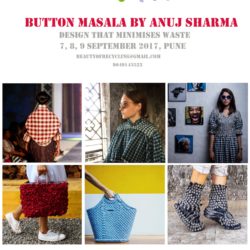THE DESIGNER : ANUJ SHARMA
Anuj Sharma is a fashion designer from NID, Ahmedabad who entered into fashion with his debut collection called Sunday Market in 2007, at Lakme fashion week, Mumbai. He showed many collections and slowly got into innovation in the field of design.
Anuj Sharma has come up with a unique method to construct clothes without any machine, tools or stitch technique. It is titled Button Masala. The method has led to the Button Masala collection,which has been shown internationally for e.g. as part of the travelling exhibition Connecting Concepts by Dutch design DFA to Netherlands, and he was also a part of the exhibition Bliss at the Taiwan design expo 2011.
He was awarded the Most Innovative Collection of the Year Award 2009 for his collection Button Masala at Marie Claire Made in India Fashion Awards.
Sharma is frequently invited as workshop leader and lecturer to talk about his innovative design and method development, for e.g. in South Africa as a part of India Africa programme, and the India Design Forum which was held at NCPA, Mumbai, 2013. In 2011 Sharma was invited by HCL to give a talk on unconventional management during World Economic Forum at Davos in Switzerland.
Sharma has also attended Fashion Coterie in New York, participated with a show at Alchemy festival in London and was selected amongst four finalists for International Young Fashion Entrepreneur of the Year award (IFFEY) by British Council, India.
THE TECHNIQUE: BUTTON MASALA
Button Masala is a simple joinery system, which replaces sewing from the clothing or home furnishing. The technique involves only buttons and rubber bands. It is pretty much like tie and dye technique but done with rubber bands. Button masala is a very quick construction method, possibly the cheapest in the world and the greenest for the environment. Each product can be recycled and restructured by simply removing the buttons and putting them in another place. The technique is also used to make carpets, bags, jewelry, shoes and many other useful products. What is nice is that that everyone can use the technique. The technique is easy to be taught and is an open source. It’s already been taught to almost 20000 people across countries.
The Beauty of Recycling aims to encourage design innovations that encourage reuse and reduce waste of any kind. Anuj is open heartedly sharing his knowledge and skill because he believes it will revolutionize the garment industry. He is also empowering the under privileged by teaching them this technique – allowing them to create their own clothes and their own products simply by knowing an easy way of putting materials together.
We feel that by teaching this technique to the poor Anuj is freeing them of the need for cash and showing them a creative way to cope with minimal resources.

